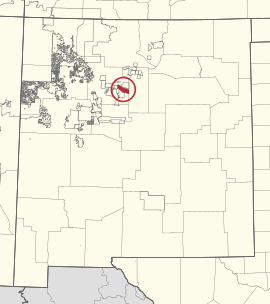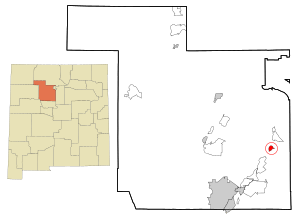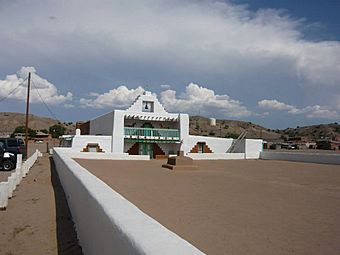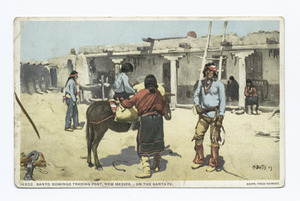Santo Domingo Pueblo, New Mexico facts for kids

Location in Sandoval County
|
|
| Total population | |
|---|---|
| 3,519 | |
| Regions with significant populations | |
| Languages | |
| Keres, English |
|
Santo Domingo Pueblo
|
|
|---|---|

Aerial image of Kewa Pueblo
|
|

Location in New Mexico
|
|
| Country | United States |
| State | New Mexico |
| County | Sandoval |
| Area | |
| • Total | 2.05 sq mi (5.32 km2) |
| • Land | 2.04 sq mi (5.28 km2) |
| • Water | 0.01 sq mi (0.04 km2) |
| Elevation | 5,187 ft (1,581 m) |
| Population
(2020)
|
|
| • Total | 2,311 |
| • Density | 1,133.95/sq mi (437.78/km2) |
| Time zone | UTC-7 (Mountain (MST)) |
| • Summer (DST) | UTC-6 (MDT) |
| ZIP code |
87052
|
| Area code(s) | 505 |
| FIPS code | 35-70810 |
| GNIS feature ID | 0928818 |
|
Pueblo of Santo Domingo (Kiua)
|
|
 |
|
| Lua error in Module:Location_map at line 420: attempt to index field 'wikibase' (a nil value). | |
| Nearest city | Albuquerque, New Mexico |
|---|---|
| Area | 48 acres (19 ha) |
| Built | 1700 |
| Architectural style | Mixed (more Than 2 Styles From Different Periods), Pueblo |
| NRHP reference No. | 73001145 |
| Added to NRHP | December 12, 1973 |
The Kewa Pueblo, also known as Santo Domingo Pueblo, is a special place in northern New Mexico. It is home to a federally-recognized tribe of Native American Pueblo people. Many of their homes are very old, some built around the year 1700.
About 2,456 people lived here in 2010. The pueblo is located in Sandoval County. It is about 35 miles (56 km) northeast of Albuquerque, New Mexico. It is also southwest of Santa Fe, near Interstate 25. A 48-acre (19 ha) part of the pueblo was added to the National Register of Historic Places in 1973.
Contents
Kewa Pueblo Culture
The people of Kewa Pueblo speak Keres, which is an eastern dialect of the Keresan languages. They have a special family system called matrilineal kinship. This means that children are part of their mother's family and clan. Property and family traditions are passed down through the mother's side.
Every year on August 4, the pueblo celebrates a big feast day. This day honors their patron saint, Saint Dominic. More than 2,000 pueblo people take part in traditional corn dances during this celebration.
How Kewa Pueblo Got Its Name
In August 1598, a Spanish explorer named Juan de Oñate met the Kewa Pueblo people. This happened on the feast day of a Catholic saint named Santo Domingo. Because of this, the Spanish later called the pueblo "Santo Domingo."
The earliest name recorded for the pueblo was Gipuy. However, the people of Kewa Pueblo have always called their home Kewa in their own Keres language. In 2009, the pueblo officially changed its name to Kewa Pueblo. They updated their official seal, signs, and letterhead to reflect this change.
The Western Keresan name for the pueblo is Díiwʾi. The people are called Dîiwʾamʾé.
Where is Kewa Pueblo?
Kewa Pueblo is located at 35.514483 degrees North and 106.363429 degrees West. It is about 25 miles (40 km) southwest of Santa Fe. Interstate 25 is about 4 miles (6 km) east of the community. The pueblo is part of the Albuquerque Metropolitan Statistical Area.
The area that covers the pueblo is about 2.0 square miles (5.2 km2). All of this area is land.
Kewa Pueblo Population
| Historical population | |||
|---|---|---|---|
| Census | Pop. | %± | |
| 2020 | 2,311 | — | |
| U.S. Decennial Census | |||
The 2010 census showed that 2,456 people lived in the area. However, 3,519 people in the U.S. said they were only Santo Domingo Puebloan. A total of 4,430 people said they were Santo Domingo Puebloan, either alone or with another group. The state of New Mexico has reported the population as 3,100.
Kewa Pueblo History
Kewa Pueblo has an important place in the history of the Spanish in this region. Francisco Vázquez de Coronado first met the Kewa people in 1540. When the Spanish arrived in the Rio Grande Valley, they found over 70 villages. These villages made goods and had a strong trading system. Kewa was one of these busy villages.
Spanish trips into the area continued after this first meeting. One such trip was by Juan de Oñate in 1598. Oñate came to Kewa Pueblo wanting to bring Kewa and nearby pueblos under Spanish rule. Soon after his visit, a church was built.
In 1680, Kewa and other pueblos fought against the Spanish. They killed four priests and Spanish settlers nearby. Similar conflicts happened again in 1696. In both cases, the Spanish eventually regained control. Later, in 1807, Lieutenant Zebulon Pike visited Kewa. He wrote in his journal that the church had beautiful paintings, including one of Saint Domingo.
A person named Gaspar Castaño de Sosa was arrested at the pueblo in March 1591. He had been exploring the Pecos River and had taken people from Pecos Pueblo. He then traveled toward modern-day Santa Fe. Captain Juan Morlette found Castaño at Kewa Pueblo and arrested him.
Castaño had left two interpreters at Kewa Pueblo. They had been taken by him earlier. When Governor Juan de Oñate's group traveled north, they met these two people, Tomas and Cristobal, at Kewa Pueblo.
Kewa Pueblo in the 20th Century
Artists from Kewa and Cochiti Pueblos have made special pottery for hundreds of years. They created different styles for various uses. Their designs also showed their deep beliefs. Since the early 1900s, people outside the pueblos have admired these pots. Kewa potters still use traditional methods. In recent times, they have also created new designs. Their pottery is now sold all over the world.
Kewa Pueblo Belief System
The Kewa people, like other Native American groups in the Rio Grande region, believe their people came from inside the Earth. They say they emerged from a place in the north called Shipap. The legend says that from Shipap, they traveled south. Along the way, smaller groups broke off. These groups then founded other pueblos.
Kewa Pueblo Art
Kewa artists are well-known for their beautiful jewelry made from stone. This includes flat disks or beads called heishi. This word means "shell bead" in their Eastern Keresan language. These beads are often made into necklaces.
Kewa Pottery
Pottery is a very important art form and useful skill in Kewa Pueblo. Large jars called ollas and bowls for dough are common items made by Kewa potters. Many Kewa potters are women, but men also create ceramics. In the 1920s, a nearby train stop in the town of Wallace brought more visitors to Kewa. This helped people notice Kewa and its pottery. During this time, pottery became a valuable item that Kewa could sell to others.
The Aguilar Family was famous for making Kewa pottery from about 1910 to 1915. This family included two sisters and one sister-in-law.
Robert Tenorio continues his family's tradition of making Kewa pottery. His sister was also part of a well-known pottery team with her husband, called Arthur and Hilda Coriz.
Education in Kewa Pueblo
Kewa Pueblo is part of the Bernalillo Public Schools district. This district runs Santo Domingo Elementary and Middle Schools. It also operates Bernalillo High School.
The school district says that students from Kewa Pueblo also attend Cochiti Elementary and Middle Schools in Peña Blanca. Some elementary students from Kewa Pueblo go to Algodones Elementary School in Algodones.
Notable People from Kewa Pueblo
Images for kids
See also
 In Spanish: Pueblo Kewa para niños
In Spanish: Pueblo Kewa para niños




